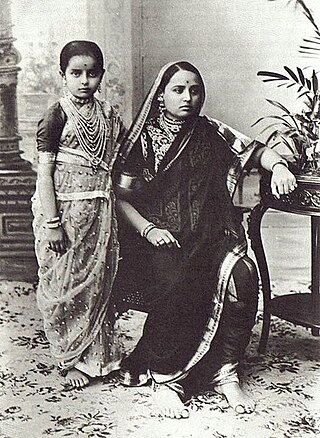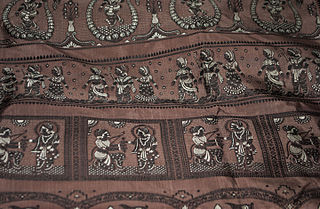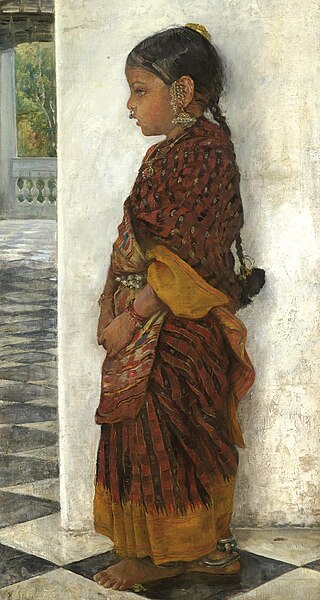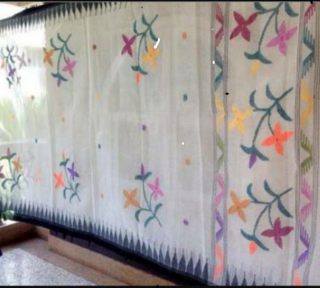
A sari is a women's garment from the Indian subcontinent, that consists of an un-stitched stretch of woven fabric arranged over the body as a robe, with one end attached to the waist, while the other end rests over one shoulder as a stole (shawl), sometimes baring a part of the midriff. It may vary from 4.1 to 8.2 metres in length, and 60 to 120 centimetres in breadth, and is form of ethnic wear in India, Pakistan, Bangladesh, Sri Lanka, and Nepal. There are various names and styles of sari manufacture and draping, the most common being the Nivi style. The sari is worn with a fitted bodice also called a choli and a petticoat called ghagra, parkar, or ul-pavadai. It remains fashionable in the Indian Subcontinent today.
Ikat is a dyeing technique originating from Indonesia used to pattern textiles that employs resist dyeing on the yarns prior to dyeing and weaving the fabric.

Jamdani is a fine muslin textile produced for centuries in South Rupshi of Narayanganj district in Bangladesh on the bank of Shitalakhwa river.

Paithani is a variety of sari, named after the Paithan town in Aurangabad district from state of Maharashtra in India where the sari was first made by hand. Present day Yeola town in Nashik, Maharashtra is the largest manufacturer of Paithani.

A Banarasi sari is a sari made in Varanasi, an ancient city which is also called Benares (Banaras). The saris are among the finest saris in India and are known for their gold and silver brocade or zari, fine silk and opulent embroidery. The saris are made of finely woven silk and are decorated with intricate design, and, because of these engravings, are relatively heavy.

Ilkal sari is a traditional form of sari which is a common feminine wear in India. Ilkal sari takes its name from the town of Ilkal in the Bagalkot district of Karnataka state, India. Ilkal saris are woven using cotton warp on the body and art silk warp for border and art silk warp for pallu portion of the sari. In some cases instead of art silk, pure silk is also used.

A Sambalpuri sari is a traditional handwoven bandha (ikat) sari wherein the warp and the weft are tie-dyed before weaving. It is produced in the Sambalpur, Balangir, Bargarh, Boudh and Sonepur districts of Odisha, India. The sari is a traditional female garment in the Indian subcontinent consisting of a strip of unstitched cloth ranging from four to nine metres in length that is draped over the body in various styles.
The handloom industry is one of the most ancient cottage industries in Salem district of Tamil Nadu, India. Salem was one of the primary handloom centers of south India. Sari, dhoti and angavasthram are made out of silk yarn and cotton yarn. In the recent past, home furnishing items are also woven, mainly for export purposes. More than 75,000 handlooms are working and the total value of cloth produced per annum is estimated at Rs.5,000 crores

The Kanchipuram silk sari is a type of silk sari made in the Kanchipuram region in Tamil Nadu, India. These saris are worn as bridal & special occasion saris by most women in Tamil Nadu, Kerala, Karnataka & Andhra Pradesh. It has been recognized as a Geographical indication by the Government of India in 2005–2006.

Baluchari Sari is a type of sari, a garment worn by women in Bangladesh and Indian States of West Bengal. This particular type of sari originated in West Bengal and is known for depictions of mythological scenes on the pallu of the sari. It used to be produced in Murshidabad but presently Bishnupur and its surrounding areas of West Bengal are the only place where authentic Baluchari saris are produced. It takes approximately one week to produce one such sari. In 2011, the Baluchari Sari was granted the status of Geographical Indication for West Bengal in India.

Pochampally sari or Pochampalli ikat is a saree made in Bhoodan Pochampally, Yadadri Bhuvanagiri district, Telangana State, India. They have traditional geometric patterns in "Paagadu Bandhu" (Ikat) style of dyeing. The intricate geometric designs find their way into sarees and dress materials. The Indian government's official airplane company, Air India, has its cabin crew wear specially designed Pochampally silk sarees.
Venkatagiri Sari is a sari style woven in Venkatagiri of Tirupati district in the Indian state of Andhra Pradesh. It was registered as one of the geographical indication from Andhra Pradesh by Geographical Indications of Goods Act, 1999. Venkatagiri saris are known for their fine weaving. These style of saris can also be found in the villages of Sengunthapuram, Variyankaval, Elaiyur, Kallathur, Andimadam and Marudhur villages.
Kovai Cora cotton or Kovai Kora cotton is a type of saree made in the Coimbatore region in Tamil Nadu, India. It has been recognized as a Geographical indication by the Government of India in 2014–15. The Devanga community are pioneers in weaving Kovai Kora cotton saris. 82 Weaver cooperative Societies in Coimbatore, Tiruppur and Erode are authorised to sell Kovai Kora cotton saris.

Handloom saris are a traditional textile art of Bangladesh and India. The production of handloom saris are important for economic development in rural India.
Mangalagiri Sarees and Fabrics are produced by performing handicraft weaving in Mangalagiri, a town in Guntur district of the Indian state of Andhra Pradesh. It was registered as one of the handicraft in the geographical indication from Andhra Pradesh by Geographical Indications of Goods Act, 1999. The Mangalagiri fabric is produced by weaving with the help of pitlooms from combed yarn by warp and woof interlacing. The fabric then undergoes the process of dyeing. The Nizam design is another characteristic of the fabric.

Dharmavaram handloom pattu sarees and paavadas are textiles woven by hand with mulberry silk and zari. They are made in Dharmavaram of Anantapur district in the Indian state of Andhra Pradesh. It was registered as one of the geographical indication from Andhra Pradesh by Geographical Indications of Goods Act, 1999.

Odisha Ikat, is a kind of ikat known as Bandhakala and Bandha, a resist dyeing technique, originating from Indian state of Odisha. Traditionally known as "Bandhakala"', "Bandha", '"Bandha of Odisha", it is a geographically tagged product of Odisha since 2007. It is made through a process of tie-dying the warp and weft threads to create the design on the loom prior to weaving. It is unlike any other ikat woven in the rest of the country because of its design process, which has been called "poetry on the loom". This design is in vogue only at the western and eastern regions of Odisha; similar designs are produced by community groups called the Bhulia, Kostha Asani, and Patara. The fabric gives a striking curvilinear appearance. Saris made out of this fabric feature bands of brocade in the borders and also at the ends, called anchal or pallu. Its forms are purposefully feathered, giving the edges a "hazy and fragile" appearance. There are different kinds of bandha saris made in Odisha, notably Khandua, Sambalpuri, Pasapali, Kataki and Manibandhi.
Kotpad Handloom is a vegetable-dyed fabric woven by the tribal weavers of the Mirgan community of Kotpad village in Koraput district, Odisha, India. Cotton sarees with solid border and Pata Anchal, duppatta with typical Buties / motifs, Scolrfs on cotton, silk, handloom stoles, and dress materials are all dyed with organic dyes. The natural dye is manufactured from the aul tree grown in this area. The Kotpad tussar silk saree with tribal art and Kotpad handloom fabrics with natural color is its specialty.

Gopalpur is a village known for producing Tussar fabrics. It is in Jajpur District in the Indian state of Odisha. This handicraft received the Geographical Indication tag by the Government of India in 2009. Tussar textiles are related to dhoti, joda, Shawl stole, scarves and saris.

Wangkhei Phee is a textile fabric made of white cotton. It is a product which is protected under the GI registration and is made throughout the Indian state of Manipur and is woven by women. The fabric is transparent, has many designs on its body, and is popularly worn by women of Manipur for marriage ceremonies and other festive occasions.
















